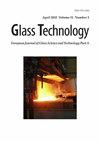Alarming Increase in Electronic Gadget Usage among Students during a Layer of the Global Pandemic
IF 0.3
4区 材料科学
Q4 MATERIALS SCIENCE, CERAMICS
Glass Technology-European Journal of Glass Science and Technology Part a
Pub Date : 2023-07-16
DOI:10.47672/ejt.1533
引用次数: 0
Abstract
Purpose: Every day, new technologies and appealing devices are released that are aimed at a large portion of our population, particularly youth, and students. These devices get young people addicted; the addiction is to frequently utilize or grow depending on the gadget. People spend a lot of time on it, and it can induce psychological and neurological disturbances, which can lead to significant problems. This study aims to determine the association between the usage of electronic gadgets on students’ physical health and cognitive skills. As COVID-19 indicated extensive use of technology, the main outcome of this study is to intervene in the impact of electronic gadgets either positive or negative on student life. Methodology: Over 01 year (Feb 21 to Jan 22), this Quantitative- Analytical Cross-sectional study was conducted at Indus University of Health and science, Korangi Crossing, Karachi. Students of three academic departments of the university participated in the study i.e., Indus College of Allied Health Sciences, Indus College of Physical Therapy, and College of Nursing. Sample size of 170 with the margin of error as 4.6% and 95% confidence level. Both male and female age group between (16 to 35) active user of social media and electronic gadgets was enrolled in study from any discipline (nursing, allied health, biosciences, medical technology etc.). Any person with mental and physical disorder previously diagnosed or under any psychological treatment or medication was not included in the study Findings: Recommendations: If the study is repeated with a larger and more representative sample (which was not possible due to COVID Pandemic) significant influence or otherwise, of time spent on electronic gadgets on physical health could also be detected.在全球流行病的一层,学生中电子设备的使用惊人地增加
目的:每天都有新的技术和吸引人的设备发布,目标是我们的大部分人口,特别是年轻人和学生。这些设备让年轻人上瘾;上瘾是经常使用或依赖于小工具。人们花很多时间在上面,它会引起心理和神经紊乱,从而导致严重的问题。本研究旨在探讨电子产品的使用对学生身体健康和认知能力的影响。由于COVID-19表明了技术的广泛使用,本研究的主要结果是干预电子产品对学生生活的积极或消极影响。方法:在1年多的时间里(2月21日至1月22日),这项定量分析横断面研究是在卡拉奇Korangi十字路口的印度卫生与科学大学进行的。该大学三个院系的学生参与了这项研究,即印度联合健康科学学院、印度物理治疗学院和护理学院。样本量为170,误差范围为4.6%,置信水平为95%。年龄在(16至35岁)之间的男性和女性都是社交媒体和电子产品的活跃用户,他们参加了来自任何学科(护理、联合健康、生物科学、医疗技术等)的研究。任何先前被诊断患有精神和身体疾病或正在接受任何心理治疗或药物治疗的人都未被纳入研究结果:建议:如果在更大、更有代表性的样本中重复研究(由于COVID大流行,这是不可能的),也可以检测到花费在电子产品上的时间对身体健康的显着影响或其他影响。
本文章由计算机程序翻译,如有差异,请以英文原文为准。
求助全文
约1分钟内获得全文
求助全文
来源期刊
CiteScore
0.30
自引率
0.00%
发文量
0
审稿时长
>12 weeks
期刊介绍:
The Journal of the Society of Glass Technology was published between 1917 and 1959. There were four or six issues per year depending on economic circumstances of the Society and the country. Each issue contains Proceedings, Transactions, Abstracts, News and Reviews, and Advertisements, all thesesections were numbered separately. The bound volumes collected these pages into separate sections, dropping the adverts. There is a list of Council members and Officers of the Society and earlier volumes also had lists of personal and company members.
JSGT was divided into Part A Glass Technology and Part B Physics and Chemistry of Glasses in 1960.

 求助内容:
求助内容: 应助结果提醒方式:
应助结果提醒方式:


